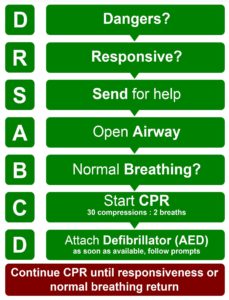BASIC LIFE SUPPORT
BASIC LIFE SUPPORT
Background
Basic Life support involves the protection of the unconscious casualty or the preservation of life through CPR & defibrillation for those not breathing. The basic life support flowchart offers us a systematic way of dealing with a medical emergency. The basic life support flow chart uses the acronym D.R.S.A.B.C.D. This can be remembered by thinking of a team of Doctors at the emergency with the names – Drs A. B. C. D.
Recognition
Any event where a person collapses or is injured, the basic life support flowchart should be followed
Management
- Follow the basic life support flowchart
- DANGER
Assess the situation and control any dangers
Observe your surroundings – Look, listen, smell & feel (doors may be hot in fire emergencies)
Electrical dangers, traffic hazards, chemical hazards, dangers of aquatic rescues and so on
If the danger cannot be controlled, a rescuer should not proceed
- RESPONSE
check casualty for consciousness
Talk & touch: ask “Can you hear me, open your eyes, what’s your name, squeeze my hands”
With intoxicated people, rubbing the sternum or the collar bone with your knuckles firmly may be needed
If conscious (responsive) begin further assessment & manage as required
If unconscious (not responsive) continue the flowchart
- SEND FOR HELP – call 000 for an ambulance and other people (if available) to support you in the rescue.
- AIRWAY – clear the airway by removing any foreign objects visible in the mouth, then tilt the head back to open the airway. If there is any fluid like vomit, blood or water in the mouth, turn the casualty on to their side to clear it out. This may also need to be done if a solid object is visible deeper in the mouth.
- BREATHING – look, listen and feel for breathing
- Place an ear over the persons mouth and turn your head to the chest of the casualty.
- Listen for the sounds of breathing and feel if any air is coming in and out.
- While doing this, look down to the chest and stomach of the casualty and watch for movement
- place a hand over the lower chest/upper stomach and feel for rise and fall.
If breathing turn the casualty into recovery position. This will ensure the airway remains clear and open, especially in the event of regurgitation.
If not breathing or not breathing normally commence CPR. If there is no rise & fall of the chest and you cannot feel or hear air coming in and out, commence CPR. In some cases, casualties may show signs of agonal gasps where the mouth appears to open and the jaw jerks oddly. There is no air going in and out. This is not normal breathing and CPR needs to commence. In other cases, a snoring type of rattle can be heard coming from the casualty’s mouth. A small amount of air may be exhaled but no air will be drawn in and there will be no chest movement. This is not normal breathing and CPR needs to commence immediately.
- CPR – provide 30 compressions – followed by 2 breaths & then continue 30:2
- If unwilling to provide breaths, continue compressions only
- DEFIBRILLATION – attach an AED as soon as one is available & follow the prompts

The Basic Life support flowchart
